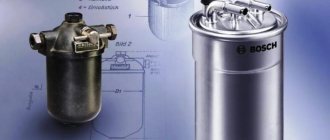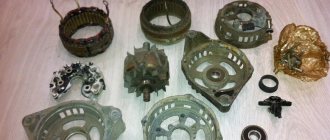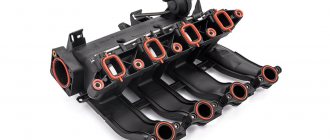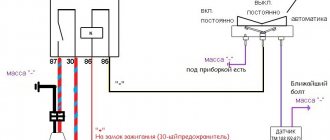Inside the box, while the car is moving and even idle in traffic jams, processes of movement and friction of various mechanisms occur. All this is accompanied by a natural increase in temperature. Since the oil in an automatic transmission is simultaneously responsible for lubrication, cooling and transmission of torque, if we talk about torque converter gearboxes, the oil itself definitely needs cooling.
A radiator is used for this. Without it, the machine will not be able to function normally. In normal operating mode, the lubricant temperature can rise to 80-100 degrees Celsius.
Yes, a certain cooling system is provided as standard. But it is not always enough to cope with the loads on the box. For such purposes, it is possible to install an additional or auxiliary radiator.
Normal temperature readings
If you look at the manual, the manufacturer clearly indicates what temperature range is considered normal for a particular automatic transmission.
Basically this range is between 60 and 90 degrees Celsius.
To maintain this temperature, the automatic transmission design provides for the use of a box cooling system. Without it, when driving a car, the temperature would hardly be below 95-100 degrees.
Although special synthetic ATF oils are used for automatic transmissions, when overheated they lose their properties and characteristics and cease to cope with their tasks.
Avoiding overload can be difficult. To minimize the possible consequences of overheating, the right solution would be to install another radiator in the cooling system.
How the cooling system works
There are different types of radiators that are responsible for cooling the working fluid inside the automatic transmission.
But the system's operation scheme looks approximately the same. It includes several main elements:
- Pump. A special device that creates pressure inside the system. Helps pump oil from the moving elements of the automatic transmission to the hopper.
- Oil receiver. It's a bunker. It includes a rectangular body with pipes on both sides. The hopper can be located inside the engine cooling radiator or at the bottom of the sump. The location allows for efficient cooling.
- Filter. Usually presented in the form of a metal mesh. But synthetic materials can also be used. The filter is needed to clean the oil from various particles and impurities that appear as a result of wear and friction of surfaces.
Some vehicles come from the factory with larger heat exchangers, which improves cooling efficiency and eliminates the need to install an additional radiator.
The operation of the automatic transmission cooling system largely depends on what type is used in a particular car.
Cooling system on old and new automatic transmissions
It is already clear that the radiator is responsible for cooling. But there are two types. These are separate and built-in.
The first type is used mainly on old automatic transmissions. Built-in ones appeared on modern machines.
Separate radiators are a privilege for older cars. For automatic transmissions, there is a separate radiator from the engine cooling radiator specifically for the gearbox. Blowing is carried out by counter air flows or forced by a fan. This allows you to maintain the temperature within a specified range.
Schematic illustration of the cooling system
For individual radiators, timely oil changes are key. It is better to do this at intervals of 50 thousand km. Although the instruction manual may indicate that replacement is carried out after 150 thousand km.
Built-in. This is an option for modern automatic transmissions that do not have a separate radiator for the gearbox. Here the pipe responsible for supplying oil to the machine is connected to the main radiator. That is, structurally, there is a pair of radiators in one unit. One cools the engine lubricant, and the second cools the oil in the box.
Switching to integrated radiators seemed like a revolutionary way to solve two cooling problems at once. In practice, everything looks different. Many engines have a higher operating temperature compared to the temperature of the automatic transmission lubricant. And if the motor can operate at 100-110 degrees, then these parameters will be disastrous for the machine.
Also, small pipes are often used to cool transmission fluid, which negatively affects cooling efficiency. Therefore, the oil may overheat under heavy load.
Initially, the built-in radiators work fine. But over time, the pipes become clogged with dirt and the cooling efficiency drops noticeably. Cleaning is quite difficult and replacement is expensive.
To solve the problem of insufficient cooling, they began to use an additional radiator, which is installed to help the main cooling unit. Such elements are mounted in the gap between the main radiator and the box.
Additional automatic transmission radiator. Improving cooling. How to extend the life and remove overheating of the machine
An automatic transmission (automatic transmission), or simply an automatic transmission, is a complex system that uses special oil (ATF fluid) as a working fluid, that is, it transmits torque from the transmission engine. It is not surprising that this liquid is very heated, often at temperatures above 100 (or even 110 degrees) Celsius. But this is very bad for the mechanism as a whole, because its temperature limits are much lower. Therefore, in order to remove excess heat (especially on not new machines), it is often advisable to install an additional cooling radiator in the system. Actually, today we will talk about this...
Probably, many have wondered, why do we need radiators for automatic transmissions at all, since there are simply no radiators in a manual transmission, as well as in a robot? YES that's true, NO! But they are present in the automatic transmission (classic torque converter) and variator, and as I wrote above, they are needed precisely to remove excess heat from the oil.
We recommend: Operating principle of the injector
In an automatic transmission, the oil heats up very significantly, because it is the working fluid and fluid friction causes torque to be transmitted.
The variator is a little different, here the torque is transmitted using a special belt (or chain), there is also heating, but not always critical. However, now it is not uncommon to find a torque converter in a design, that is, now the variator is not rigidly connected to the engine. On the one hand, this prolongs the life of the variator, because there are no hard shocks and jerks from the engine (they are nevertheless smoothed out), on the other hand, there is still the same warm-up.
In any case, you need a cooling radiator, REGULAR! BUT it is not always enough.
What does installing an additional radiator give?
Not everyone sees the point in an additional radiator for an automatic transmission and does not understand why install it. After all, the automaker must calculate everything during design and provide the required degree of cooling.
In reality, it is impossible to calculate the load perfectly accurately. Somewhere the machine is less susceptible to negative influences. And in difficult conditions, the intensity of wear and overheating increases noticeably. The manufacturer takes average values. Plus, it is beneficial for them to have cars repaired and replaced more often. You should not completely rely on the manufacturer.
There are several reasons to install an auxiliary radiator:
- the system better resists overheating;
- oil rarely heats above 80 degrees Celsius;
- the overall resource of the automatic transmission increases;
- the lubricant lasts longer and needs replacement less often;
- solenoids and valve body are better protected from wear.
It is important to understand that the additional radiator will constantly cool the oil. Because of this, everything works fine in the summer, but in winter, underheating of the lubricant will lead to negative consequences.
To solve this problem in winter, you need to additionally use the thermostat. It allows the cooling system to operate exactly at the moment when it is needed.
The thermostat allows, at a certain temperature, to supply lubricant to a large cooling circle. Usually it is 70-80 degrees Celsius. This will allow you to regulate the temperature inside the system depending on environmental conditions and the intensity of the automatic transmission.
A little theory
Add. radiator for automatic transmission
In cars with a mileage of over 100 thousand km, installing an additional radiator normalizes the operation of the transmission and increases its service life. This is explained by the fact that in cars with high mileage, the cooling system works less efficiently than in new cars. A decrease in the efficiency of the box is facilitated by the formation of deposits on transmission mechanisms, leakage of lubricant through worn seals, and the occurrence of vibrations from worn components. All these problems lead to overheating of the oil inside the automatic transmission.
For automatic transmissions (3- and 4-speed), the optimal operating temperature is 75-800C. In such temperature conditions, the service life of the automatic transmission is longer than the operating period of the machine itself. In the classic version, which is used for most cars, the automatic transmission cooling pipe is located in the main radiator of the internal combustion engine. At the same time, as the degree of wear of the vehicle increases, the cooling efficiency of the automatic transmission decreases. A moment arises when, during long-term operation of the car, the engine temperature is equal to the temperature of the automatic gearbox and is about 1000C, which is unacceptable for automatic transmissions.
Modern universal lubricants have a synthetic base that allows the oils to withstand extremely high temperatures without breaking down or changing the structure specified by the manufacturer. But for automatic transmissions, an increase in the temperature of the lubricant, even by 100C, can damage the mechanisms of the unit and significantly worsen their performance. When the temperature of the transmission fluid is more than 1400C, carbonization of the friction clutches occurs, overheating of the friction lining is possible (critical temperature about 3500C) and its premature wear. Obviously: even using universal transmission oils that can withstand extremely high temperatures, it will not be possible to avoid automatic transmission overhaul without a good cooling system.
We recommend: Types of brake fluid
Extremely low temperatures of the lubricant are also harmful to the automatic transmission, so experts recommend installing a thermostat on the cooling line in winter. This device prevents cold transmission oil from cooling through an additional oil cooler and returns lubricant to the transmission.
Installation of auxiliary radiator
Self-installation of an additional radiator for an automatic transmission is completely acceptable. But to do this, you need to have at least minimal knowledge of the machine’s structure and experience in servicing it.
Before the installation is completed, you need to decide on the choice of an additional radiator, since 2 types of units can be installed on the automatic transmission.
- Tubular. Their hydraulic resistance has minimal indicators. The internal cavities do not fill with dirt as often as those of a competitor. When clogged, they can self-clean and wash out. They are connected to the side of the standard unit. There are 4, 6 and 8-row ones. The first ones are suitable for passenger cars with an engine capacity of up to 2.0 liters, which drive without a trailer and in not particularly difficult conditions. For engines up to 3 liters, 6-row engines are suitable. When driving with a load, it is better to choose 8-row.
- Lamellar. Many people prefer to install an additional plate radiator to cool their automatic transmission. Their efficiency during the first 3-4 years of operation is higher than that of a competitor by 10-30%. At the same time, they filter the lubricant and trap large debris. It is then effectively leveled.
We should also highlight products in the form of radiators without a turbulence spiral. This remote type of device is important to use if automatic transmissions become very hot during operation, and their oil pump has high performance indicators. But in practice they are rarely used, since they are very demanding on the quality of the poured oil.
Structurally, cars differ from each other, so it is impossible to create universal instructions that are suitable for absolutely all cars. To install an oil cooler, you usually need:
- dismantle the front bumper and remove the left air duct;
- choose a suitable place behind the radiator grille;
- the installation should be carried out so that the element can be cooled by a fan and counter air flows;
- the additional radiator is secured into the gap with special ties;
- hoses of a suitable diameter are put on the tubes and secured with clamps;
- reinforced hoses are connected to the factory system using adapters;
- the auxiliary thermostat is connected;
- additional volume of transmission lubricant is added.
Check the connected system for leaks before starting active operation of the vehicle.
Self-installation of an additional radiator for the factory automatic transmission cooling system is quite possible. With it, the automatic transmission will work better and longer. Oil changes will be required less often.
Automatic transmission cooling system: radiator and automatic transmission radiator
Modern cars use cooling systems that allow not only to cool the moving elements of the box, but also to lubricate them. The automatic transmission cooling system consists of:
- cooling radiator with heat exchanger;
- cooling system pump;
- cooling system pipes;
- liquid temperature sensor;
- transmission fluid (ATF).
The design of the automatic transmission radiator is practically no different from the radiator for internal combustion engines. The principle of operation is also similar, that is, automatic transmission oil is pumped through the radiator for cooling.
As a rule, the box cooling radiator consists of the following elements:
- upper and lower tanks (made of brass to ensure good thermal conductivity);
- core (thin transverse plates and flat vertical tubes soldered to these plates);
- fastening parts.
Another thing worth noting is the heat exchanger, which acts as part of the main cooling radiator. Subject to operation in a midland climate, a heat exchanger (an additional circuit in the radiator of the cooling system) is used to maintain a constant temperature in the hydraulic environment of the automatic transmission. Most often, the heat exchanger is built into the radiator of the box.
In regions with high air temperatures, cars are equipped with an additional heat exchanger, usually installed in front of the cooling radiator.
Please note that it is necessary to monitor the condition of the heat exchanger, which tends to become clogged both outside and inside, as a result of which it fails to perform its direct functions (the ability to remove heat from the box decreases, rapid wear of friction linings, etc.).
Possible problems and their solutions
There are several problems associated with the automatic transmission cooling system that usually arise for those who decide to install an additional radiator.
- In winter, the lubricant thickens, and an additional radiator increases the time it takes to warm up the oil in the automatic transmission. A cold start provokes accelerated wear, oil leaks through squeezed out oil seals. To solve this problem you need to install a thermostat. But you should still start only after the automatic transmission and internal combustion engine have warmed up.
- The additional radiator needs to be cleaned, and this requires special equipment. In fact, cleaning can be done using a submersible or furnace pump. The second option is better.
- After installing an additional radiator, the temperature is still high. Look for the problem in a stuck thermostat, old worn-out lubricant, or a dirty automatic transmission.
- An automatic transmission with an additional radiator requires much more oil. This is a common myth. The volume will increase only by the capacity of the radiator, pipes and hoses. In practice, costs increase slightly.
An additional radiator is a truly useful and effective solution when operating automatic transmissions in difficult conditions. It is important to choose the part correctly and install it correctly, not forgetting about the thermostat. It is not recommended to use such a system without it.











